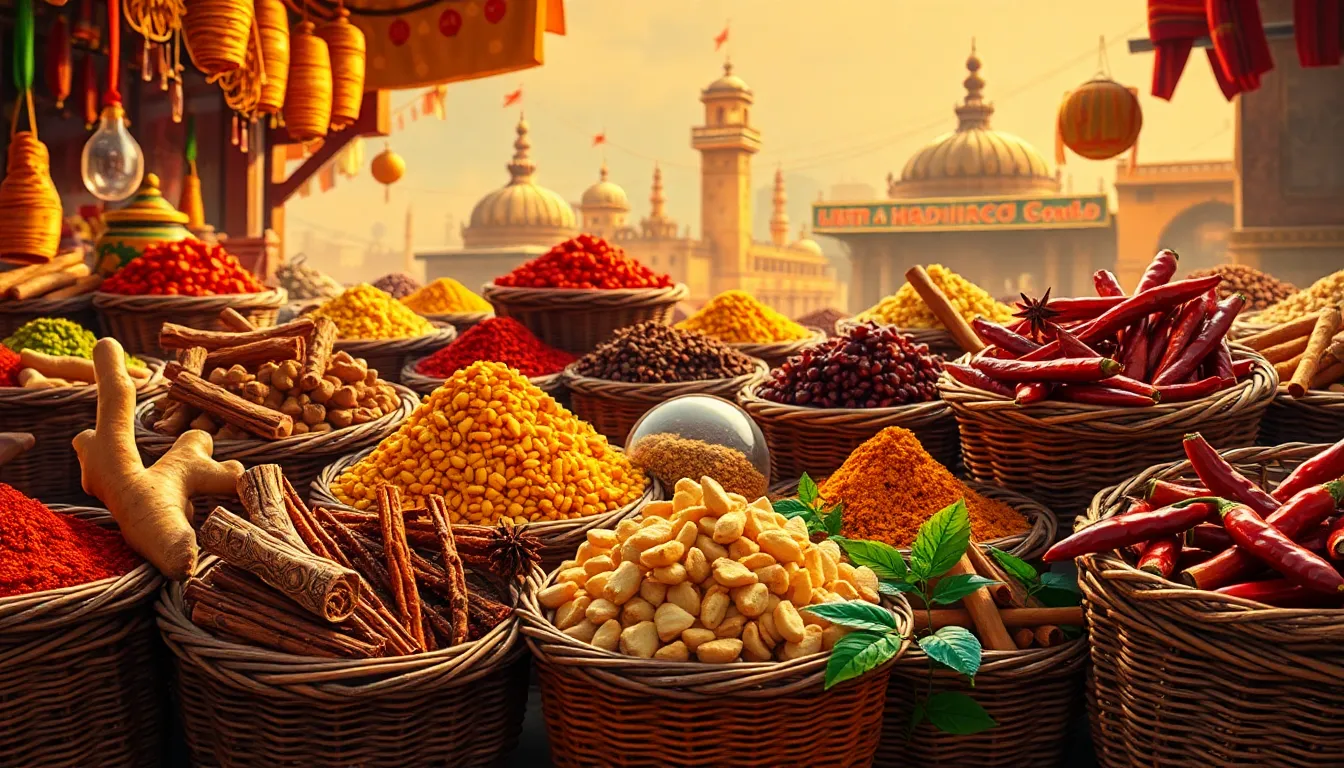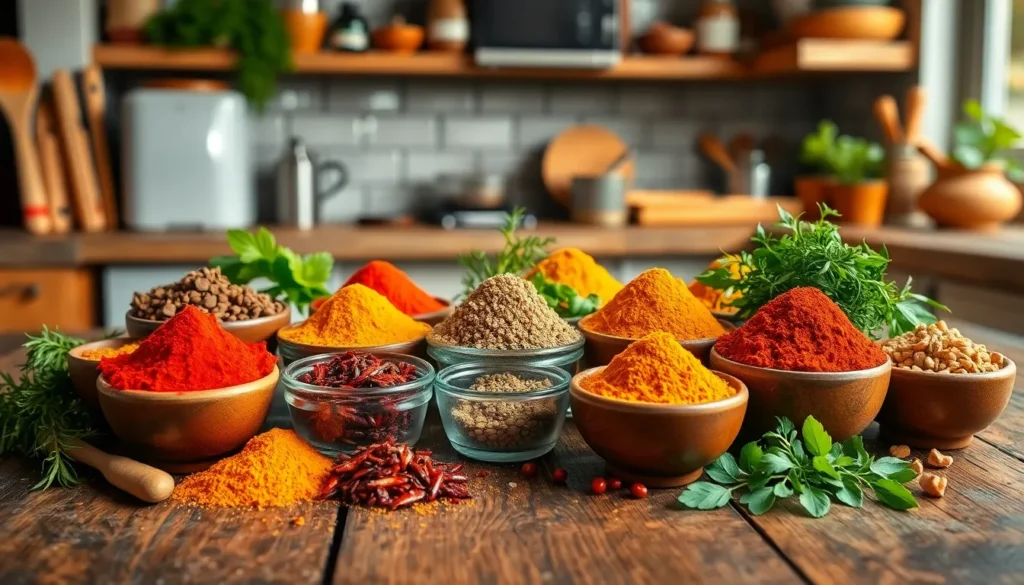Table of Contents
ToggleSpices are the unsung heroes of the culinary world, transforming bland dishes into flavor-packed masterpieces. Imagine biting into a dish that dances on your taste buds, each spice telling its own story. It’s like a party in your mouth, and everyone’s invited!
But here’s the kicker: many people stick to the same old salt and pepper routine. What a snooze-fest! By exploring the vibrant world of spices, they can elevate their cooking game and impress even the pickiest eaters. From fiery chilies to aromatic herbs, the right spice can turn an ordinary meal into a culinary adventure. So why settle for mediocrity when a sprinkle of creativity can lead to delicious discoveries? Dive into the world of spice usage and unlock the secrets to making every meal an unforgettable experience.
Overview of Spice Usage
Spices play a critical role in cooking by enhancing flavors and aromas. Chefs and home cooks alike utilize spices to create distinctive taste profiles. Variety exists in spices; each contributes its unique characteristics. Common spices include cumin, coriander, and turmeric, known for their boldness and nutritional benefits.
Herbs, often confused with spices, come from green plants and contribute freshness, as seen with basil and parsley. Their pairing with spices can create complex layers of flavor in dishes. For instance, the combination of rosemary and garlic elevates roasted meats, providing depth to the overall experience.
Regional cuisines highlight specific spices that define cultural identities. Indian cuisine prominently features cardamom, while Mexican dishes thrive on the heat of chili peppers. These spices not only evoke emotion but also enhance the dining experience.
Experimentation with spices encourages creative culinary endeavors. Mixing different spices can result in unexpected yet delightful combinations, such as cinnamon in savory dishes or black pepper alongside chocolate. Understanding the balance of flavors becomes essential for achieving culinary excellence.
Quantities matter in spice usage; too much of a potent spice can overwhelm a dish. Typically, a teaspoon of a strong spice suffices for enhancing flavor in a recipe. Adjusting spice levels based on personal preferences can lead to unique adaptations of traditional dishes.
Knowledge of spice pairings further enhances culinary creativity. For example, garlic and oregano work harmoniously in Mediterranean cuisine, while nutmeg complements creamy sauces beautifully. Mastering these pairings can elevate any cook’s repertoire.
Historical Significance of Spices

Spices shaped history, influencing economies and culinary practices worldwide. Their trade led to the establishment of key routes connecting diverse cultures.
Ancient Trade Routes
Ancient civilizations relied on spices to boost their economies. The Silk Road served as a critical pathway, facilitating trade between East and West. Spices like cinnamon and ginger traveled long distances, enhancing both cuisine and trade wealth. These routes not only promoted the exchange of goods but also the sharing of culinary knowledge, creating a rich tapestry of global flavors. Merchants prioritized spice transport, leading to the rise of cities along these trade corridors. Historical accounts reveal that precious spices helped fund explorations, altering the course of empires.
Cultural Impact on Cuisine
Spices contributed significantly to cultural identity, forming the backbone of regional cuisines. Indian curries exhibit a complex blend of spices, showcasing a rich culinary heritage. In contrast, Italian dishes often emphasize the freshness of herbs alongside specific spices, reflecting local agriculture. Culinary practices evolved around spices, influencing rituals, celebrations, and daily meals. Communities embraced unique spice blends, which became signatures of their respective cultures. Traditional recipes passed down through generations illustrate this continued significance, highlighting spices as essential components of communal identity and pride.
Types of Spices and Their Uses
Spices enrich dishes and offer unique flavors. Explore the following categories for insights on their diverse applications.
Common Culinary Spices
Cumin enhances savory dishes with its warm, earthy flavor. Paprika adds a vibrant color and mild heat, perfect for stews. Turmeric, known for its health benefits, lends a golden hue and a slightly bitter note to curries. Coriander seeds provide a citrusy undertone that works well in spice blends. Oregano brings a robust aroma, ideal for Italian cuisine. Mustard seeds add a zesty kick in pickles and dressings. Black pepper, a staple seasoning, elevates nearly any dish with its sharp bite.
Medicinal Properties of Spices
Turmeric contains curcumin, recognized for its anti-inflammatory and antioxidant properties. Ginger aids in digestion and alleviates nausea, making it a popular remedy. Cinnamon regulates blood sugar levels, enhancing overall metabolic health. Garlic, known for its antibacterial effects, supports immune function. Fenugreek seeds may reduce cholesterol levels, benefiting heart health. Cloves exhibit antiviral properties, effective in fighting infections. Cardamom acts as a digestive aid and may provide relief from bloating.
Regional Variations in Spice Usage
Spices vary widely across regions, each culture showcasing distinctive flavors and culinary traditions.
Asian Cuisine
Asian cuisine features a broad array of spices that create complex flavors. In India, cardamom and cumin stand out, while Sichuan peppercorn adds a unique numbing sensation in Chinese dishes. Thai cooking often incorporates lemongrass and galangal, contributing aromatic qualities. Curry blends, commonly found in Southeast Asian recipes, highlight the interplay of multiple spices for rich, layered flavors. Each spice plays a vital role in forging the distinctive tastes that define different Asian culinary styles.
Mediterranean Cuisine
Mediterranean cuisine celebrates aromatic herbs and spices like oregano, basil, and sumac. Greek dishes often showcase dill and mint, enhancing the freshness of ingredients. In North African cooking, spices such as cumin, coriander, and saffron significantly enrich tagines and couscous. Additionally, spice blends like za’atar highlight specific regional flavors unique to certain areas. This diversity in spice usage emphasizes the connection between ingredients and cultural heritage across the Mediterranean region.
Latin American Cuisine
Latin American cuisine is renowned for its vibrant spice profiles, with chili peppers dominating many dishes. In Mexican cooking, varieties like guajillo and ancho not only provide heat but also contribute deep flavors to sauces and salsas. Cumin remains essential in both Mexican and Central American cuisines, while coriander offers a fresh contrast. Additionally, spices like achiote are pivotal in traditional dishes like cochinita pibil, exemplifying the region’s rich culinary tapestry. Such combinations reflect the cultural significance of spices in Latin American gastronomy.
Modern Trends in Spice Usage
Spices play a pivotal role in modern cooking and healthy eating habits. Health consciousness drives individuals to seek flavor alternatives that enhance meals without adding excessive calories or sodium.
Health Consciousness and Spices
Many consumers incorporate spices for their health benefits. Turmeric, known for its anti-inflammatory properties, garners attention in health circles. Garlic contributes to cardiovascular health, while ginger aids digestion. People often opt for spices over traditional seasoning methods to elevate dishes without compromising nutritional value. This trend reflects a growing awareness of the impacts of diet on overall wellness.
Innovative Culinary Applications
Innovative culinary applications embrace spices beyond traditional recipes. Chefs experiment with spice blends to create unique sauces and marinades, enhancing flavor profiles. Restaurants increasingly feature specialty drinks infused with spices, like spiced cocktails and turmeric lattes. Home cooks also use spices creatively in desserts, with cinnamon in baked goods and chili in chocolate dishes. This evolution highlights the versatility of spices, making them essential for both casual and gourmet cooking.
Embracing the world of spices opens up endless possibilities in the kitchen. By experimenting with different flavors and combinations, cooks can create dishes that not only satisfy the palate but also nourish the body. The rich history and cultural significance of spices add depth to culinary practices, making each meal a celebration of tradition and innovation.
As individuals explore new spice profiles, they’ll discover how these ingredients can transform everyday cooking into an art form. Whether through bold regional flavors or health-conscious alternatives, spices remain a vital component in both enhancing taste and promoting wellness. With a little creativity and knowledge, anyone can elevate their cooking game and enjoy the myriad benefits that spices have to offer.



